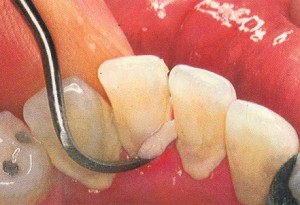Scaling? Root planing ? These are everyday dental terms which sort of sound like something used in the field of engineering or construction. To a certain extent, there seems to be a muddle up of understanding about these two terms, what they are, and why they are even needed. This article aims to clear up the air of confusion.
Like nearly all dental problems it all originates from plaque. Plaque is a soft sticky bio-film formed by bacteria which is rather easily cleaned through the use thorough and proper tooth brushing habits. However, should plaque be allowed to build up (due to improper tooth brushing technique or total neglect of oral hygiene.) it may take up trace minerals in ordinary salivary and harden to form what is known as dental calculus, a tenacious solid mass which is nearly impossible to remove through tooth brushing. Without removal of these substances, you are opening the door to gum infection, tooth loss and even serious internal diseases.
Scaling is the removal of plaque, calculus along with any other superficial stains. These two deposits adhere on the surface of the tooth; at and above the level of the gums (supragingival scaling), and below that of the level of the gums (subgingival scaling). The armamentarium used in scaling can range from manually driven hand scalers to ultrasonic scalers. Ultrasonic scalers use the kinetics of high frequency vibration to loosen and break up large chunks of calculus from the surface of the tooth. Hand scalers on the other hand, are finely crafted instruments designed to conform to the shape of the tooth. They are used in a sort of scraping motion in order to remove the fine deposits of calculus left behind by the ultrasonic scaler. In some places however, the usage of ultrasonic scalers is completely shunned and hand scalers are preferred from start to finish. Root planing is the removal of any infected tooth structure and the planing the root of the tooth in order to smoothen it. As subgingival scaling tends to leave behind some remnants of infected cementum at the root structure and the sharp instruments leaving rough surfaces on the root, it leaves a window open for delayed healing and even a repeated build up of plaque and calculus due to a rough surface that increases the adherence of these deposits. This procedure is usually indicated immediately after subgingival scaling especially in cases with deep periodontal pockets (deep pockets in the gums) which provide low-oxygen conditions allowing for dangerous bacteria to grow.
The problem with scaling and root planing is at times they have both become an item together. However, there is a fine line to limit the extent of treatment planning by your dentist. Scaling is indicated when the calculus deposits are lined up at or above the level of the the gum. The teeth in question do not show signs of severe gum disease like tooth mobility and deep pocketing. This procedure is usually done as prophylaxis; that is to prevent further progression to a more severe form of gum disease.
Scaling AND Root Planing is done once signs of severe gum disease are detected. Gingivitis if left unchecked can and will progress to periodontitis, a more severe form of gum disease. The hallmarks of periodontitis are bone loss, deep pocketing and tooth mobility. Scaling is done below the gumline, in order to remove bacterial deposits and toxins. This is the succeeded by root planing which attempts to scrape of infected cementum on the root of the tooth, and smoothen the roughened surfaces of the root. This is to prevent those rough surfaces from becoming a plaque stagnating area. As such, a procedure like this is expected to cost significantly more as well as require a longer appointment duration.
Your dentist or periodontist would know what would be the best treatment to be done and design it accordingly based on their findings. When in doubt however, do not hesitate to question them regarding their diagnosis as you are on the paying side of it. Refrain from making personal attacks and seek a secondary opinion if you are unsatisfied.

Is it nessary to have your blood preeser taken before the cleaning